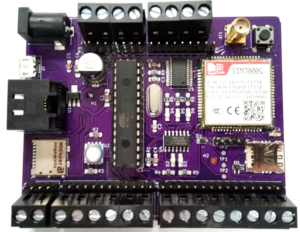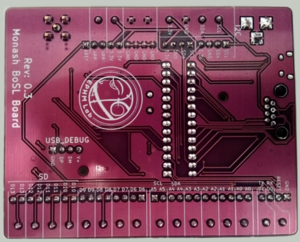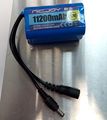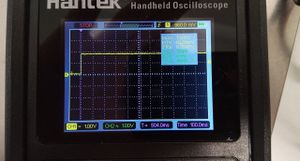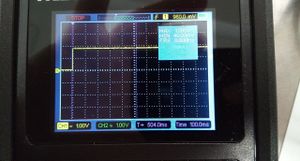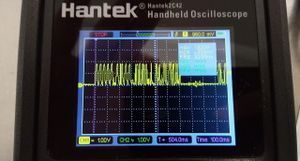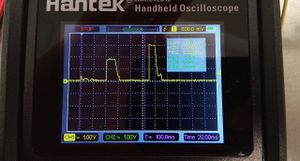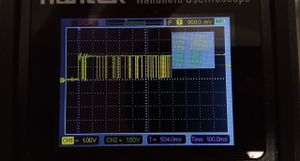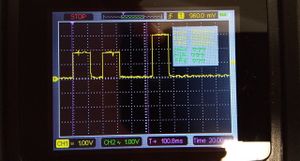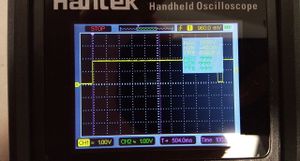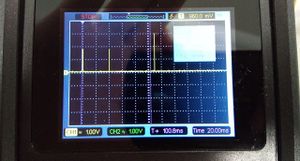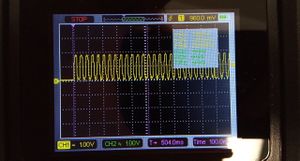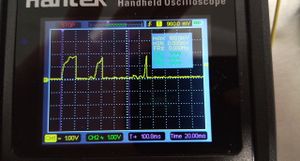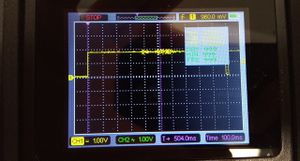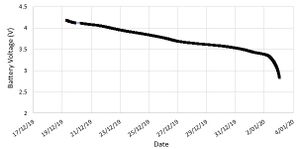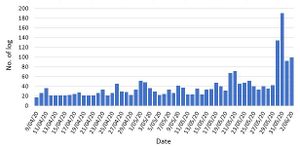Difference between revisions of "BoSL Board v0.3"
| (14 intermediate revisions by 3 users not shown) | |||
| Line 15: | Line 15: | ||
Electrical Specifications: <br> | Electrical Specifications: <br> | ||
| + | Min Input Voltage: 3.0 V <br> | ||
Max Input Voltage: 5.5 V <br> | Max Input Voltage: 5.5 V <br> | ||
Typical Sleep Current: -- μA <br> | Typical Sleep Current: -- μA <br> | ||
| Line 121: | Line 122: | ||
==== New Battery Test ==== | ==== New Battery Test ==== | ||
| − | New batteries were set up on 5 on five BoSL boards as an endurance test to see how long each would last. The graphs of various results are displayed below. | + | New batteries were set up on 5 on five BoSL boards as an endurance test to see how long each would last. The graphs of various results are displayed below. The linearity in the loggins time graph suggests that the Arduino is logging at regular and consistent intervals (in this test about 577 times per day). The battery's voltage is linear down to about 3300 mV, and then declines sharply before cutting out. The majority of the battery's capacity is thus above the 3300 mV threshold required for in-spec operation of the BoSL board. Extrapolating out the data to a once per hour transmit rate, it is estimated that the BoSL board will have a battery life of just under one year. |
<gallery> | <gallery> | ||
| Line 128: | Line 129: | ||
Log Time.png|Graph of Number of Loggins vs Time | Log Time.png|Graph of Number of Loggins vs Time | ||
</gallery> | </gallery> | ||
| + | |||
| + | ==== ALDI Mobile SIM Test ==== | ||
| + | |||
| + | ALDI mobile does not have access to the CAT-5m network and so it need to be tested whether the BoSL board can upload using ALDI-mobile SIM card on the 4g network, as being able to do so would be of great cost savings. | ||
| + | From testing the ALDI sim's worked when the APN was changed to mdata.net.au and the regular transmit procedure for was followed. | ||
==== SIM7000 SIM CARD COMMUNITCATION ISSUE ==== | ==== SIM7000 SIM CARD COMMUNITCATION ISSUE ==== | ||
| Line 228: | Line 234: | ||
|| No Reading | || No Reading | ||
|} | |} | ||
| + | ===Battery Usage=== | ||
| + | some can be copied from above. | ||
| + | ====Chinese 3.7 volt 12Ah==== | ||
| + | [[File:Blue china.jpg|thumb|Challenge Test]] | ||
| + | |||
| + | The 3.7V lithium-ion battery was tested to understand how many times of data transmission it can undertake before the battery is dead. | ||
| + | |||
| + | The BoSL board, in this challenge test, was programmed to upload measured pressure, temperature and battery level every minute. The test was started on 19th Dec 2019 with a fully charged battery (4.18V). BoSL board stopped logging on 3rd Jan 2020 with a battery voltage level of 2.83V. During this 15-day test, data was transmitted for 8,546 times. | ||
| + | |||
| + | ====D-size 3.6 volt 19Ah==== | ||
| + | A D-size non-rechargeable lithium battery (3.6V, 19Ah) was purchased from an online supplier Element 14. Due to the higher capacity of this D-size battery, BoSL development team originally hope this battery can bring longer lifetime to our BoSL boards. The battery was tested in the field up in the Dandenong Mountain. The BoSL board logger, in this project, was programmed to have a variable logging interval (max. 1 min, but min. a hour). | ||
| + | |||
| + | [[File:D size.jpg|thumb]] | ||
| + | |||
| + | |||
| + | The test started on 9th Apr 2020 and the BoSL board stopped uploading on 2nd Jun 2020. In this 55-day test, data were transmitted 2,184 times to our online data server. Due to the current COVID-19 restriction, we have not brought the sensor module back to check the remaining battery level. But based on the current result, it is clear that the Chinese blue battery performs better than the D-size battery. | ||
| + | |||
| + | == MQTT == | ||
| + | |||
| + | For details on how to use MQTT with the board check out [[MQTT]] | ||
Latest revision as of 01:29, 13 April 2023
BOSL BOARD - THE ULTRA LOW POWERED IOT LOGGING DEVICE
This little beauty costs less than an Arduino and Sim5320a put together, yet it comes already assembled, runs on 4v, is ultra low power consuming (we removed all the overheads of the off the shelf arduinos) and can send data via the CAT-M1 or NB-IoT networks! We estimate that these things can log each minute for over 12months!
Contents
Specifications
Physical Specifications:
Board Width: 88 mm
Board Length: 68.5 mm
Board Height: 18 mm
Weight:
Electrical Specifications:
Min Input Voltage: 3.0 V
Max Input Voltage: 5.5 V
Typical Sleep Current: -- μA
Supply Current Surge Requirement: -- mA
Physical Layout
Reference Table: BoSL Board Front
| 1 | DC Power Jack |
| 2 | I2C IO |
| 3 | Power IO |
| 4 | Antenna Connector |
| 5 | Reset Button |
| 6 | SIM Card Holder |
| 7 | Digital IO |
| 8 | Analog IO |
| 9 | Analog IO\TTL Header |
| 10 | Integrated Pressure\Temperature Sensor |
| 11 | SD Card Holder |
| 12 | 8P8P Modular Connector |
| 13 | Micro USB Port |
BoSL BOARD V0.3 PIN LAYOUT
| ATmega328P Pin Number | Arduino IDE pin | Internal Use | Application Notes |
|---|---|---|---|
| 1 | Reset | RST | Pull Low to reset Arduino |
| 2 | D0 | USB RX | Free for use when no micro-USB connected |
| 3 | D1 | USB TX | Free for use when no micro-USB connected |
| 4 | D2 | SIM7000 RX | Not Available for use |
| 5 | D3 | SIM7000 TX | Not Available for use |
| 6 | D4 | SIM7000 On/Off | Not Available for use |
| 7 | VCC | VCC | N/A |
| 8 | GND | GND | N/A |
| 9 | Crystal | XTAL | Not Available for use |
| 10 | Crystal | XTAL | Not Available for use |
| 11 | D5 | SIM7000 DTR | Not Available for use |
| 12 | D6 | None | Free for use |
| 13 | D7 | None | Free for use |
| 14 | D8 | None | Free for use |
| 15 | D9 | None | Free for use |
| 16 | D10 | SD Chip Select | Free for use with no SD card inserted |
| 17 | D11 | SD MOSI | Free for use with no SD card inserted |
| 18 | D12 | SD MISO | Free for use with no SD card inserted |
| 19 | D13 | SD Serial Clock | Free for use with no SD card inserted |
| 20 | VCC | VCC | N/A |
| 21 | Aref | None | Free for use |
| 22 | GND | GND | N/A |
| 23 | A0 | None | Free for use |
| 24 | A1 | None | Free for use |
| 25 | A2 | None | Free for use |
| 26 | A3 | None | Free for use |
| 27 | A4 | SDA | Free for use when not operating I2C bus |
| 28 | A5 | SCL | Free for use when not operating I2C bus |
Low Power Sleep Guide
New Battery Test
New batteries were set up on 5 on five BoSL boards as an endurance test to see how long each would last. The graphs of various results are displayed below. The linearity in the loggins time graph suggests that the Arduino is logging at regular and consistent intervals (in this test about 577 times per day). The battery's voltage is linear down to about 3300 mV, and then declines sharply before cutting out. The majority of the battery's capacity is thus above the 3300 mV threshold required for in-spec operation of the BoSL board. Extrapolating out the data to a once per hour transmit rate, it is estimated that the BoSL board will have a battery life of just under one year.
ALDI Mobile SIM Test
ALDI mobile does not have access to the CAT-5m network and so it need to be tested whether the BoSL board can upload using ALDI-mobile SIM card on the 4g network, as being able to do so would be of great cost savings. From testing the ALDI sim's worked when the APN was changed to mdata.net.au and the regular transmit procedure for was followed.
SIM7000 SIM CARD COMMUNITCATION ISSUE
2019/11/21:
There has been an issue where some of our boards aren't recognising the SIM cards, and so can't upload any data. To detect is if the issue is present the following AT command sequence can be sent.
GOOD RESPONSE
| Command | Response |
|---|---|
| AT+CFUN=0 | |
| +CPIN: NOT READY | |
| OK | |
| AT+CFUN=1 | |
| OK | |
| +CPIN = READY | |
| SIM READY |
BAD RESPONSE
| Command | Response |
|---|---|
| AT+CFUN=0 | |
| +CPIN: NOT READY | |
| OK | |
| AT+CFUN=1 | |
| OK | |
| +CPIN: NOT INSERTED |
We did some probing around with an oscilloscope to see if there were any electrical differences between the good and bad boards. Both had identical measured crystal frequencies of 7.9 - 8.1 MHz and SIM7000 - ATmega382p baud rates of about 9540.
The one difference which was found was in the signals issued from the SIM 7000 to the SIM card on pins SIM_VDD, SIM_RST, SIM_CLK, and SIM_DATA. They are quite different. Notably the bad boards only power the SIM VDD line for 3 pulses of 24 ms long whereas the working boards good boards keep this line high. The measurements are taken after the AT+CFUN=1 command is issued in the above test sequence.
In doing some reading on the issue it seems to have been encountered before, with the conclusion that it likely a soldering issue, possible inside the SIM7000 modual, thus leaving little course for it to be able to repaired.
for boards with a SIM inserted
| PIN | Good Board | Bad Board |
|---|---|---|
| SIM_VDD | ||
| SIM_RST | ||
| SIM_CLK | ||
| SIM_DATA | No Reading |
for boards without a SIM inserted
| PIN | Good Board | Bad Board |
|---|---|---|
| SIM_VDD | ||
| SIM_RST | ||
| SIM_CLK | ||
| SIM_DATA | No Reading |
Battery Usage
some can be copied from above.
Chinese 3.7 volt 12Ah
The 3.7V lithium-ion battery was tested to understand how many times of data transmission it can undertake before the battery is dead.
The BoSL board, in this challenge test, was programmed to upload measured pressure, temperature and battery level every minute. The test was started on 19th Dec 2019 with a fully charged battery (4.18V). BoSL board stopped logging on 3rd Jan 2020 with a battery voltage level of 2.83V. During this 15-day test, data was transmitted for 8,546 times.
D-size 3.6 volt 19Ah
A D-size non-rechargeable lithium battery (3.6V, 19Ah) was purchased from an online supplier Element 14. Due to the higher capacity of this D-size battery, BoSL development team originally hope this battery can bring longer lifetime to our BoSL boards. The battery was tested in the field up in the Dandenong Mountain. The BoSL board logger, in this project, was programmed to have a variable logging interval (max. 1 min, but min. a hour).
The test started on 9th Apr 2020 and the BoSL board stopped uploading on 2nd Jun 2020. In this 55-day test, data were transmitted 2,184 times to our online data server. Due to the current COVID-19 restriction, we have not brought the sensor module back to check the remaining battery level. But based on the current result, it is clear that the Chinese blue battery performs better than the D-size battery.
MQTT
For details on how to use MQTT with the board check out MQTT
